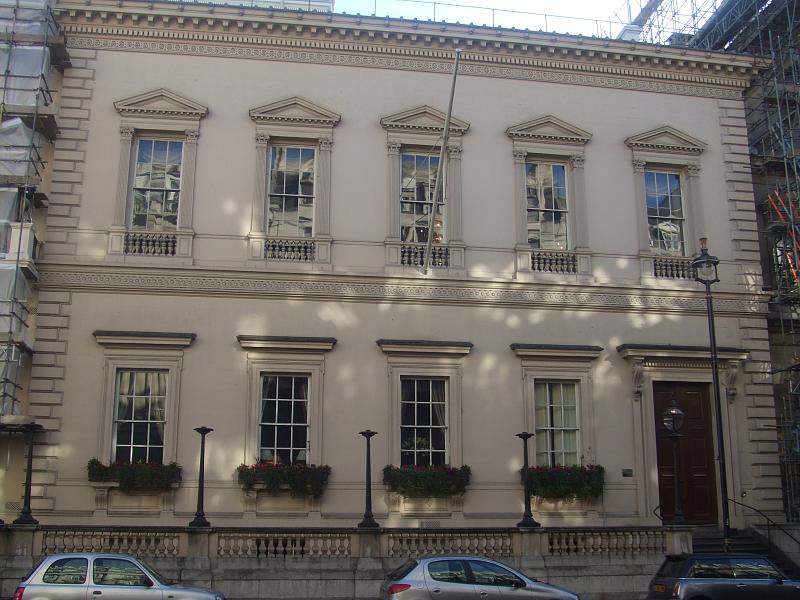The Travellers Club was founded in 1819 to provide congenial surroundings for those who had ‘travelled outside the British Islands to a distance of 500 miles from London in a direct line’, and opportunities to meet distinguished foreign visitors. As it nears its bicentenary, John Martin Robinson has produced a thorough, scholarly and highly readable biography on an institution that has served among other things as the ‘Foreign Office Canteen’ and a refuge for derring-do adventurers.
The Club’s members included royalty, dukes, ambassadors and explorers, not to mention aesthetes, artists and even authors, despite Anthony Powell’s claims to the contrary. Explorers included Lt Col William Leake, who surveyed the Nile as far as the cataract, and bought his future bride in the Cairo slave market; and Francis Younghusband, who was appointed Commissioner to Tibet by Lord Curzon, after extensive travels through Central Asia. He secured a peace treaty with the locals, which was repudiated by the Foreign Office, earning him both a knighthood and an official reprimand. In more recent years, Wilfred Thesiger has maintained the tradition with his exploration of and publications on the Arabian peninsula. The most famous ambassadors were Talleyrand, for whom the Club fitted an extra handrail to the stairs to help him negotiate them with a club foot, and Baron Von Ribbentrop, the only member to be hanged.
Charles Barry was commissioned as architect for a new building in 1828. His style ranged from Italian Renaissance to English Carolean: the exterior of this new Club derived mainly from the Raphael’s Palazzo Pandolfini in Florence, whereas the richly carved staircase inside harks back to English examples of the 1630s and 1640s. It was much praised when finished in 1832: James Stuart Wortley wrote: ‘The House is really charming and does infinite credit to our architect Mr Barry.’ Such sentiments continued posthumously: John MacVicar Anderson, the great club architect of the 1890s, made every effort to make his alterations as unobtrusive as possible, out of respect to his predecessor.
The Travellers Club often served as a recreation for politicians at the end of a hard day in Parliament, and blackballing for political reasons was considered ‘not done’. The Club’s political influence was probably at its peak during the Crimean war. Two prime ministers, the Earl of Aberdeen and Viscount Palmerston, were members, as were Lord Raglan and Lord Cardigan. M. Salmon, the Club’s cook (‘cooks’ did not become ‘chefs’ until 1875) advised Florence Nightingale on army catering. A lasting legacy was the cigarette, introduced from Turkey, and the demand for better accommodation for smokers.
The Staff (as they were known after 1875) were treated considerately so long as they did not fail in their duties. There was a Servants’ Provident Fund that supplied their pensions when they retired. The committee tended to back them when members complained, although there was a somewhat quaint embargo on female servants ‘giggling and romping’. Cooks were mostly French, but they all too frequently left. After the 11-year stint of M. Salmon, Robinson tells us ‘things descended once more into French farce’, although sometimes retrieved by those with greater staying power.
Up until the first world war, the Club mostly ran at a profit. However, the war took its toll on membership — 50 members and two staff — and also the finances. The Club ran at a loss well into the 1920s, but by the 1930s it enjoyed something of an Indian summer. During the second world war the casualties were about half those of the previous one, but the building sustained extensive bomb damage. However, the finances were healthier, and after the war the Club prospered under a charismatic secretary, Wing Co. Robin McDouall. For decades he ran the Club with great flair but sadly he often turned a blind eye to structural problems and tried to pretend that the newly introduced VAT simply did not exist.
By the time of his retirement in 1975, the Club’s finances were in a parlous state, eventually to be salvaged and put back on track after George Webb, a former MI6 director, took over as chairman in 1987. He saw to it that those with experience in hotel management were chosen over mere experts in management-speak. The Club’s deficits and overdrafts were diminished, cooking vastly improved and sold-off items restored. Webb’s legacy has lasted, and the Club has gone from strength to strength, under the chairmanship of various ambassadors and Field Marshall Lord Bramall.






Comments